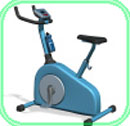
Expert
Recommend Exercise Tips
How
Much Exercise Is Enough?
START
SLOW, AND WORK UP
 For
the greatest overall health benefits, experts recommend
that you do 20 to 30 minutes of aerobic activity three
or more times a week and some type of muscle strengthening
activity and stretching at least twice a week. However,
if you are unable to do this level of activity, you can
gain substantial health benefits by accumulating 30 minutes
or more of moderate-intensity physical activity a day,
at least five times a week.
For
the greatest overall health benefits, experts recommend
that you do 20 to 30 minutes of aerobic activity three
or more times a week and some type of muscle strengthening
activity and stretching at least twice a week. However,
if you are unable to do this level of activity, you can
gain substantial health benefits by accumulating 30 minutes
or more of moderate-intensity physical activity a day,
at least five times a week.
If
you have been inactive for a while, you may want to start
with less strenuous activities such as walking or swimming
at a comfortable pace. Beginning at a slow pace will allow
you to become physically fit without straining your body.
Once you are in better shape, you can gradually do more
strenuous activity.
Moderate-intensity
Activity
Moderate-intensity activities include some of the things
you may already be doing during a day or week, such as
gardening and housework. These activities can be done
in short spurts -- 10 minutes here, 8 minutes there. Alone,
each action does not have a great effect on your health,
but regularly accumulating 30 minutes of activity over
the course of the day can result in substantial health
benefits.
To
become more active throughout your day, take advantage
of any chance to get up and move around. Here are some
examples:
-
Take
a short walk around the block
-
Rake leaves
-
Play actively with the kids
-
Walk up the stairs instead of taking the elevator
-
Mow the lawn
-
Take an activity break -- get up and stretch or walk
around
-
Park your car a little farther away from your destination
and walk the extra distance
The
point is not to make physical activity an unwelcome chore,
but to make the most of the opportunities you have to be
active.
Aerobic
Activity
 Aerobic
activity is an important addition to moderate-intensity
exercise. Aerobic exercise is any extended activity that
makes you breathe hard while using the large muscle groups
at a regular, even pace. Aerobic activities help make your
heart stronger and more efficient. They also use more calories
than other activities. Some examples of aerobic activities
include:
Aerobic
activity is an important addition to moderate-intensity
exercise. Aerobic exercise is any extended activity that
makes you breathe hard while using the large muscle groups
at a regular, even pace. Aerobic activities help make your
heart stronger and more efficient. They also use more calories
than other activities. Some examples of aerobic activities
include:
Using
Aerobic Equipment (i.e., treadmill, stationary bike):
 To
get the most health benefits from aerobic activity, you
should exercise at a level strenuous enough to raise your
heart rate to your target zone. To find your target zone,
use our target heart rate calculator.
To
get the most health benefits from aerobic activity, you
should exercise at a level strenuous enough to raise your
heart rate to your target zone. To find your target zone,
use our target heart rate calculator.
Your
heart should be beating within your target heart rate zone.
If your heart is beating faster than your target heart rate,
you are exercising too hard and should slow down. If your
heart is beating slower than your target heart rate, you
should exercise a little harder.
When
you begin your exercise program, aim for the lower part
of your target zone. As you get into better shape, slowly
build up to the higher part of your target zone. If exercising
within your target zone seems too hard, exercise at a pace
that is comfortable for you. You will find that, with time,
you will feel more comfortable exercising and can slowly
increase to your target zone.
Stretching
and Strengthening Exercises:
Stretching and strengthening exercises such as weight training
should also be a part of your physical activity program.
In addition to using calories, these exercises strengthen
your muscles and bones and help prevent injury.




 For
the greatest overall health benefits, experts recommend
that you do 20 to 30 minutes of aerobic activity three
or more times a week and some type of muscle strengthening
activity and stretching at least twice a week. However,
if you are unable to do this level of activity, you can
gain substantial health benefits by accumulating 30 minutes
or more of moderate-intensity physical activity a day,
at least five times a week.
For
the greatest overall health benefits, experts recommend
that you do 20 to 30 minutes of aerobic activity three
or more times a week and some type of muscle strengthening
activity and stretching at least twice a week. However,
if you are unable to do this level of activity, you can
gain substantial health benefits by accumulating 30 minutes
or more of moderate-intensity physical activity a day,
at least five times a week. Aerobic
activity is an important addition to moderate-intensity
exercise. Aerobic exercise is any extended activity that
makes you breathe hard while using the large muscle groups
at a regular, even pace. Aerobic activities help make your
heart stronger and more efficient. They also use more calories
than other activities. Some examples of aerobic activities
include:
Aerobic
activity is an important addition to moderate-intensity
exercise. Aerobic exercise is any extended activity that
makes you breathe hard while using the large muscle groups
at a regular, even pace. Aerobic activities help make your
heart stronger and more efficient. They also use more calories
than other activities. Some examples of aerobic activities
include:  To
get the most health benefits from aerobic activity, you
should exercise at a level strenuous enough to raise your
heart rate to your target zone. To find your target zone,
use our target heart rate calculator.
To
get the most health benefits from aerobic activity, you
should exercise at a level strenuous enough to raise your
heart rate to your target zone. To find your target zone,
use our target heart rate calculator.